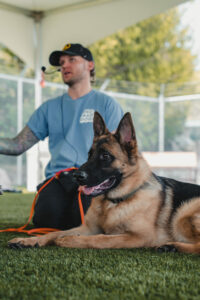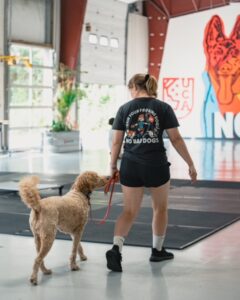Walking a reactive dog may be a difficult and stressful experience for both the dog and the owner. Reactive behavior, such as lunging, barking, or snarling at other dogs, can add stress and irritation to everyday walks. However, with the correct knowledge and tactics, you may turn your walks into fun and beneficial experiences.
This post will go over seven vital techniques for walking your reactive dog safely and stress-free. You can create a harmonious walking routine that strengthens the bond between you and your furry companion by understanding reactive behavior, effectively preparing, implementing training techniques, managing triggers, practicing effective leash handling, and seeking professional help.
What is Reactive Behavior?
Reactive behavior in dogs is defined as an extreme reaction to specific stimuli or triggers. It can appear as barking, lunging, growling, or leash pulling. Reactive dogs frequently experience anxiety, fear, or defensiveness in specific settings, which leads to these reactive behaviors.
Reactive dogs can be set off by a range of stimuli, including encounters with unknown canines, humans, bicycles, or loud noises. These triggers might differ from dog to dog, so it’s critical to recognize what sets off your canine companion to successfully manage their behaviors.
To properly deal with reactivity, you must detect the warning signals that your dog is ready to respond. These symptoms may include bodily stiffness, heightened hackles, intense staring, or pulling on the leash. Understanding these indicators allows you to take proactive steps to prevent the issue from escalating.
Tips for Walking a Reactive Dog
Preparing for Safe Walks with a Reactive Dog
Investing in the right equipment, such as a training collar and a durable leash, will help you keep your reactive dog under control on walks.
When dealing with a reactive dog, it is critical to choose a safe walking area. Avoid crowded areas or areas with a lot of foot traffic until your dog feels more at ease. To lessen the likelihood of triggering reactive behavior, take quieter routes or consider walking during off-peak hours as you work on their reactivity.
Recognize that progress takes time and that your dog will have good and bad days. Accepting these variations and remaining patient will assist you and your cat in successfully navigating this path.
Establishing a Strong Foundation through Training
Teaching your dog to heel, sit, stay, and leave it builds a solid basis for handling reactive behavior. By teaching your dog these commands, you will be able to acquire more control over him in difficult situations.

Engaging your dog’s attention and directing it toward you can assist in diverting their attention away from potential triggers. Simple exercises like maintaining eye contact or teaching them to “watch me” can be useful tools for keeping your dog calm and focused on walks.
Desensitization and counterconditioning strategies involve progressively and positively introducing your dog to their triggers. You may help improve your dog’s emotional response and lower their reactivity over time by associating these triggers with positive experiences such as treats or play.
Implementing Reinforcement Techniques
Both positive and negative reinforcement is required when working on reactive behavior. Positive reinforcement, such as rewarding your dog with treats or praise for excellent behavior, is a strong strategy. However, correcting the reactive behavior with a training collar such as a slip lead, and implementing a “leave it” command is the other half of improving reactivity. The combination of teaching the dog to stop reacting and rewarding the dog when they do not react will allow you to achieve long-term success without needing to feed your dog treats during your entire walk.
Using treats and toys as motivators during training can make your dog’s learning experience more fun and gratifying. Experiment with various sorts of treats or toys to see which ones your pet prefers. These positive reinforcements will keep your dog interested and motivated to work with you.
Managing Triggers and Reducing Anxiety on Walks
Walking a reactive dog is similar to negotiating a minefield. You never know what will set off their alarms and drive them into a tailspin. It is critical to know what causes your dog’s reactive behavior so you can work on addressing this behavior. If you find yourself unexpectedly confronted with a trigger, remember to remain calm and carry on (or at least try to). Most dog owners struggling with reactivity benefit from the help of an experienced behavioral trainer.
Practicing Effective Leash Handling Skills
Let’s face it: gripping a leash is an art. If it’s too tight, your dog will feel limited and will respond much more. On the other hand, you don’t want it to be too loose, because you’ll end up chasing after your dog like a crazy person. Find a happy balance by keeping the leash loose but in control. Remember, you’re in command here, not your canine buddy (despite their best efforts).
Commonly, a dog’s reactivity stems from the owner’s handling and overall relationship with their dog. It’s important to focus on how you are communicating with your dog through the leash. Your body language and tone of voice are a couple of things that matter to the dog and can either increase or decrease a dog’s reactivity.
Seeking Professional Help and Support for Reactive Dogs
Let’s face it, we all need a little assistance from time to time. If walking your hyperactive dog has turned into a daily battle, it’s time to call in the pros. An experienced dog trainer can offer essential advice and skills to assist you and your pet in navigating the world together. Plus, they’ve probably seen it all, so there’s no need to pass judgment.

Some reactive dogs may require further assistance to overcome their worries and concerns. Professional behavior modification programs can provide structured and targeted therapies to meet the individual needs of your dog. It’s alright to ask for help, and it doesn’t mean you’re a bad dog parent. We all have eccentricities, and our furry buddies are no exception.
FINAL THOUGHTS
You can overcome the hurdles of walking a reactive dog with confidence and ease if you use these crucial strategies and techniques. Keep in mind to be patient, consistent, and positive during the process, as progress may take some time. You can create a safe and stress-free walking experience for both you and your reactive dog with understanding, good preparation, and the right support. You can gain from exercise, fresh air, and a closer friendship as a result of overcoming problems together. Have fun walking!
Expert Dog Daycare and Training in Clifton Park NY!
Our mission is to give dogs a voice and provide owners with the knowledge they need to live the best life possible with their dogs. Join the movement!
Click Here to Subscribe to our YouTube Channel for More Videos of Dog training.
Contact us or visit Upstate Canine for more blogs.
